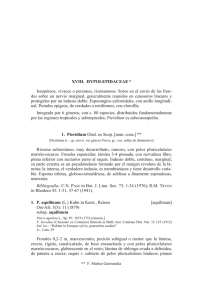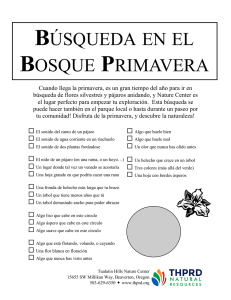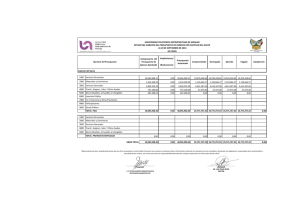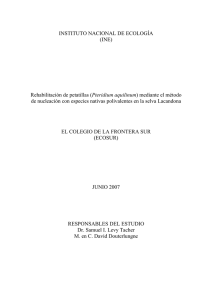Composición bromatológica de Pteridium aquilinum subs
Anuncio
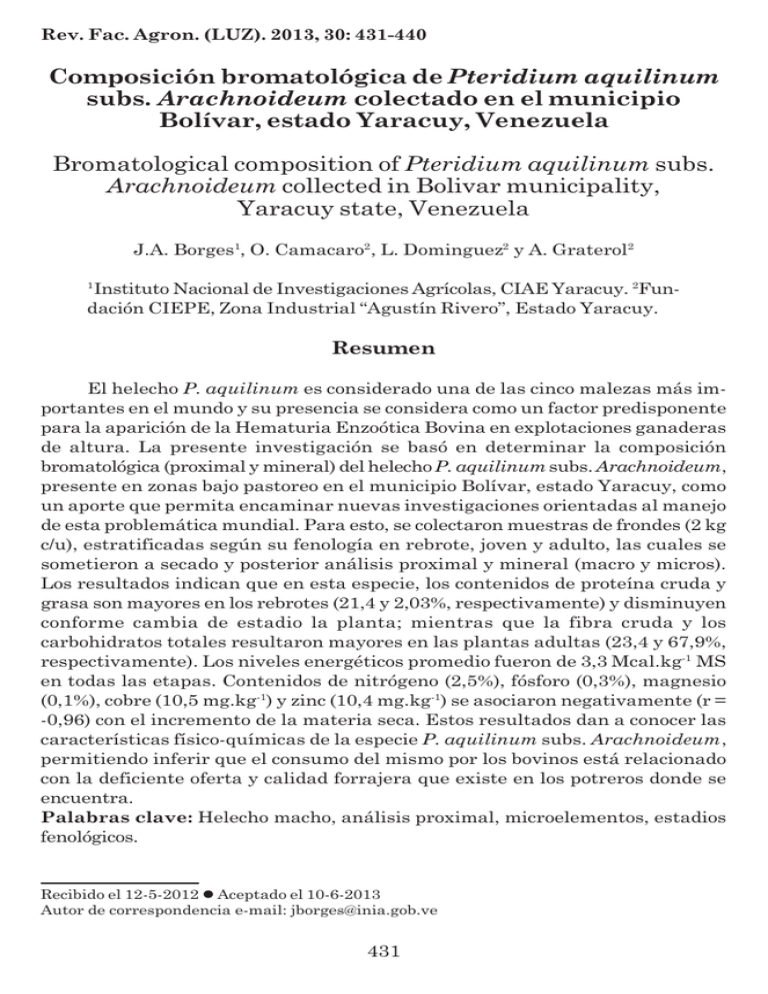
Rev. Fac. Agron. (LUZ). 2013, 30: 431-440 Composición bromatológica de Pteridium aquilinum subs. Arachnoideum colectado en el municipio Bolívar, estado Yaracuy, Venezuela Bromatological composition of Pteridium aquilinum subs. Arachnoideum collected in Bolivar municipality, Yaracuy state, Venezuela J.A. Borges1, O. Camacaro2 , L. Dominguez2 y A. Graterol2 Instituto Nacional de Investigaciones Agrícolas, CIAE Yaracuy. 2Fundación CIEPE, Zona Industrial “Agustín Rivero”, Estado Yaracuy. 1 Resumen El helecho P. aquilinum es considerado una de las cinco malezas más importantes en el mundo y su presencia se considera como un factor predisponente para la aparición de la Hematuria Enzoótica Bovina en explotaciones ganaderas de altura. La presente investigación se basó en determinar la composición bromatológica (proximal y mineral) del helecho P. aquilinum subs. Arachnoideum, presente en zonas bajo pastoreo en el municipio Bolívar, estado Yaracuy, como un aporte que permita encaminar nuevas investigaciones orientadas al manejo de esta problemática mundial. Para esto, se colectaron muestras de frondes (2 kg c/u), estratificadas según su fenología en rebrote, joven y adulto, las cuales se sometieron a secado y posterior análisis proximal y mineral (macro y micros). Los resultados indican que en esta especie, los contenidos de proteína cruda y grasa son mayores en los rebrotes (21,4 y 2,03%, respectivamente) y disminuyen conforme cambia de estadio la planta; mientras que la fibra cruda y los carbohidratos totales resultaron mayores en las plantas adultas (23,4 y 67,9%, respectivamente). Los niveles energéticos promedio fueron de 3,3 Mcal.kg-1 MS en todas las etapas. Contenidos de nitrógeno (2,5%), fósforo (0,3%), magnesio (0,1%), cobre (10,5 mg.kg-1) y zinc (10,4 mg.kg-1) se asociaron negativamente (r = -0,96) con el incremento de la materia seca. Estos resultados dan a conocer las características físico-químicas de la especie P. aquilinum subs. Arachnoideum, permitiendo inferir que el consumo del mismo por los bovinos está relacionado con la deficiente oferta y calidad forrajera que existe en los potreros donde se encuentra. Palabras clave: Helecho macho, análisis proximal, microelementos, estadios fenológicos. Recibido el 12-5-2012 Aceptado el 10-6-2013 Autor de correspondencia e-mail: jborges@inia.gob.ve 431 Borges et al. Abstract The fern P. aquilinum is considered one of the five most important weeds in the world and their presence are considered as a predisposing factor for the occurrence of Bovine Enzootic Haematuria in farms of high zones. This research was based on determining the chemical composition (proximal and mineral) of the fern P. aquilinum subs. Arachnoideum present in grazing areas in Bolivar municipality, Yaracuy state, as a contribution to enable new research-oriented routing management of this global problem. For this, samples were collected fronds (2 kg c/u), stratified by phenology in regrowth, young and adult frond, which were subjected to drying and subsequent proximate and mineral analysis. The results indicate that in this species, the crude protein and fat are higher in regrowth (21.4 and 2.03%, respectively) and decrease as the plant changes its stage, while crude fiber and total carbohydrates were higher in adult plants (23.4 and 67.9%, respectively). The average energy levels were 3.3 Mcal.kg-1 DM in all stages. Nitrogen content (2.5%), phosphorus (0.3%), magnesium (0.1%), copper (10.5 mg.kg-1 ) and zinc (10.4 mg.kg-1) is negatively associated (r = -0.96) with the increase of the dry matter. These results disclose the physicochemical characteristics of P. aquilinum subs. Arachnoideum, allowing the inference that the same consumption by cattle is related to poor quality forage supply and there in the fields where it is located. Key words: fern, proximal analysis, microelements, phenology phases. Introducción Introduction El helecho macho (Pteridium aquilinum (L.) (Hühn), además del daño ocasionado por la tradicional interferencia biológica sobre plantas cultivadas, es una maleza muy peligrosa en potreros, debido a su toxicidad para los animales que la consumen (Sánchez, 1996), creciendo profusamente en las zonas montañosas húmedas y semihúmedas de toda Venezuela (Ortega, 1991). Según Alonso-Amelot (1999), en Centro y Suramérica se tienen dos de las doce variedades que existen en el mundo, la Caudatum y la Arachnoideum. Su presencia se considera como un factor predisponente para la aparición de la Hematuria Enzoótica Bovi- Male fern (Pteridium aquilinum (L.) (Hühn), besides the dame caused by the traditional biologic interference on cropped plants, is a very dangerous weed in paddocks due to its toxicity for the animals that eat it (Sánchez, 1996), it grows in humid and semi-humid mountain areas throughout Venezuela (Ortega, 1991). According to AlonsoAmelot (1999), in Central and South America there are two out of the twelve varieties that exist in the world, these are Caudatum and Arachnoideum. Their presence are considered key factors for the appearance of Bovine Enzootic Haematuria (HEB) and other pathologies related to the cattle exploitation located in high lands; it has 432 Rev. Fac. Agron. (LUZ). 2013, 30: 431-440 na (HEB) y otras patologías asociadas en las explotaciones ganaderas ubicadas en zonas altas, así como también se ha señalado (Alonso-Amelot, 1999) que esta planta pudiese ser la causante o coadyuvante del alto índice de cáncer gástrico en humanos observado en zonas montañosas de Venezuela. Particularmente en el estado Yaracuy, los productores pecuarios y sus rebaños ubicados a más de 600 msnm se enfrentan con esta problemática, especialmente en los municipios Bolívar y Nirgua, ya que en estas zonas tradicionalmente cafetaleras, en los últimos años han cambiado de rubro de forma drástica, deforestando y quemando indiscriminadamente, con el consecuente favorecimiento de las condiciones para que el helecho se reproduzca de forma invasiva y por consiguiente aparezcan las toxicosis en los rebaños bovinos allí establecidos (Camacaro et al., 2010). Las investigaciones respecto al helecho han sido dirigidas a la determinación de sus constituyentes toxicológicos más que a sus características físico-químicas, posiblemente por ser considerada como una planta indeseable y sin interés económico. Sin embargo, se han encontrado antecedentes sobre las trazas minerales contenidas en esta planta (Hunter, 1953), así como también Stuart et al. (2006), han señalado una digestibilidad del 53,1% de la materia seca en esta especie. Aunque resulta escasa, esta información podría ser el punto de partida para lograr explicar el por qué, un animal tan selectivo en su dieta como lo es el bovino, termina consumiendo esta planta toxica. Por lo antes expuesto, el objetivo de la presente investiga- also been mentioned (Alonso-Amelot, 1999) that this plant might also be the cause of the gastric cancer in humans observed in mountain areas in Venezuela. In Yaracuy state, the cattle producers along to the their animals located at 600 masl, face this problem, especially those in Bolívar and Nirgua counties, since in these traditionally coffee cities, in the last years have changed drastically slashing and burning, consequently, favoring all the conditions for the fern to reproduce invasively, thus, appearing the toxic diseases in the cattle (Camacaro et al., 2010). The researches carried out in ferns have been committed to the determination of their toxicological constituents rather than to their physicchemical characteristics, maybe because it is considered an unwanted plant with none economic interest. However, findings have been found about the mineral traces constituted in this plant (Hunter, 1953) and Stuart et al. (2006) have mentioned the digestibility of 53.1% of the dry matter on this specie. Even though this information is little and limited, is useful and the starting point to explain the reason of why such a selective animal such as the bovine, ends up eating this toxic plant. Because of the latter, the objective of this research was based on determining the bromatological composition (proximal and mineral) of the fern P. aquilinum subs. Arachnoideum, as a guide for further researchers oriented to the handle of this worldwide problem. Materials and methods A cattle production unit located at 1.229 masl, coordinates N: 10º22’24'’ 433 Borges et al. ción se basó en determinar la composición bromatológica (proximal y mineral) del helecho P. aquilinum subs. Arachnoideum, como un aporte que permita encaminar nuevas investigaciones orientadas al manejo de esta problemática mundial. and W: 68º57’30'’ was chosen, in Bolivar County, Yaracuy state, where there is a high population density of the fern (7±2 individuals/m2) in the areas established as paddocks. The classification of the sub-species was done identifying the leaflets by their shape and color, according to AlonsoAmelot and Rodulfo-Baechler (1996), finding 90% of predominance of the subs. Arachnoideum. Complete samples (fronds) of this specie were collected, with an average weight of 2 kg each, stratifying them by growth’s phase: resurgence, young and adult, which were cut in the soil’s level, put on identified plastic bags and stored in a freezer. Subsequently, the samples were let dried in a stove at 65ºC for 72 hours and divided into aliquots for their analytical processing. A proximal analysis was done to determine the contents of dry matter (MS), crude protein (PC), ethereal extract (EE), ashes (CZ), crude fiber (FC), total carbohydrates (CHO) and energy (EM) as nutritional parameters, according to the analytical procedures mentioned by FONAIAP (1999). Likewise, a foliar analysis was carried out to determine the macro and micro mineral elements present such as nitrogen (N) by the method Kjeldahl, phosphorous (P) by photocolorimetry and potassium (K), calcium (Ca), magnesium (MG), zinc (Zn), copper (Cu), iron (Fe) and manganese (Mn) quantified by spectrophotometry of atomic absorption according to the methods employed by Sadzawka et al. (2004). The data was tabulated, obtaining the average value ± standard deviation (DE) and submitted to the Pearson correlation analysis to verify Materiales y métodos Para fines de esta investigación, se ubicó una unidad de producción bovina situada a 1.229 msnm, bajo las coordenadas N: 10º22’24'’ y W: 68º57’30'’ en el municipio Bolívar del estado Yaracuy, donde existe una alta densidad poblacional del helecho (7±2 individuos.m2 ) en las áreas establecidas como potreros. La clasificación de las subespecies se realizó mediante la identificación de las pinulas por forma y color, según lo señalado por AlonsoAmelot y Rodulfo-Baechler (1996), encontrandose un 90% de predominancia de la subs. Arachnoideum, con la cual se procedió el estudio. Se colectaron muestras completas (frondes) de esta subespecie, con un peso promedio de 2 kg cada una, estratificándose por estadio de crecimiento en rebrote, joven y adulto, las cuales fueron cortadas a ras del suelo, colocadas en bolsas plásticas identificadas y almacenadas en cava refrigerada. Posteriormente las muestras fueron secadas en estufa a 65ºC durante 72 horas y separadas en alícuotas para su procesamiento analítico. Se realizó un análisis proximal para determinar los contenidos de materia seca (MS), proteína cruda (PC), extracto etéreo (EE), cenizas (CZ), fibra cruda (FC), carbohidratos totales (CHO) y energía (EM) como parámetros 434 Rev. Fac. Agron. (LUZ). 2013, 30: 431-440 nutricionales según los procedimientos analíticos señalados por FONAIAP (1999). Así mismo se realizó un análisis foliar para determinar los macro y microelementos minerales presentes como Nitrógeno (N) por método Kjeldahl, fósforo (P) por fotocolorimetría y potasio (K), calcio (Ca), magnesio (Mg), zinc (Zn), cobre (Cu), hierro (Fe) y manganeso (Mn) cuantificados por espectrofotometría de absorción atómica, de acuerdo a los métodos explicados por Sadzawka et al. (2004). Los datos fueron tabulados, obteniéndose su valor promedio ± desviación estándar (DE) y sometiéndose a análisis de correlación de Pearson para verificar la asociación entre algunos parámetros estudiados, empleando el software InfoStat/Profesional v.1 (InfoStat, 2002). the association between some of the studied parameters, employing the software InfoStat/Profesional v.1 (InfoStat, 2002). Results and discussion The results of the proximal analysis done in the plants, according to their phenologic phase, are presented on table 1. It can be observed an increment in the dry matter of the fern at the time that it goes from one phenologic phase to another, reaching 43.3% once the fern becomes adult, corresponding to an increment in the contents of crude fiber (r= 0.98) and total carbohydrates (r= 1.00/p= 0.06), that might be responsible of the rigidity of the fronds and stems by the increment of the cellular wall. The total carbohydrates (CT) are the ones that can be accumulated and easily translocated to other parts of the plant for its metabolism. Typical examples include the glucose, sucrose, fructose, raffinose and starch polysaccharide (Ríos, 1985). Aronsson et al. (1976), say that there is a correlation among the increments of the levels of some carbohydrates and the roughness of plants at low temperatures and/or reduced photoperiods, which might be explained by the habitat conditions where the fern is mainly located (high areas with cold weather). The contents of crude protein, ethereal extract (fats) and ashes (mineral content) showed a tendency to reduce as the physiological ripening phases passes, with a negative correlation (r=-1,00; -0,98 y -0,86, respectively) with the increment of the dry matter in the plant. On this matter, Norton (1981) pointed out that Resultados y discusión Los resultados del análisis proximal realizado en las plantas de acuerdo a su estadio fenológico se presentan en el cuadro 1. Se puede observar un aumento en la materia seca del helecho a medida que pasa de un estadio fenológico a otro, llegando al 43,3% una vez que el helecho se hace adulto, correspondiendo con un aumento en los contenidos de fibra cruda (r= 0,98) y carbohidratos totales (r= 1,00/p = 0,06), que pudiesen ser los responsables de la rigidez de los frondes y tallos por aumento de la pared celular. Los carbohidratos totales (CT) son aquellos que pueden ser acumulados y fácilmente traslocados a otras partes de la planta para su metabolismo. Ejemplos típicos incluyen a la glucosa, sacarosa, 435 Borges et al. Cuadro 1. Análisis proximal del helecho P. aquilinum subs. Arachnoideum de acuerdo a su estadio fenológico. Table 1. Proximal analysis of fern P. aquilinum subs. Arachnoideum according to its phenolic phase. Estadio fenológico Rebrote Materia seca Proteína cruda Extracto etéreo Cenizas Fibra cruda Carbohidratos totales Energía* Joven 16,9 21,44 2,03 6,94 18,12 55,47 3,26 35,6 14,41 1,57 5,52 21,01 65,35 3,33 Adulto Promedio ±DE 43,3 12,30 1,19 5,88 23,43 67,96 3,32 31,9±13,6 16,1±4,8 1,6±0,4 6,1±0,7 20,9±2,7 62,9±6,6 3,3±0,04 Valores expresados en porcentaje; *(Mcal/kg MS) fructosa, rafinosa, y el polisacárido almidón (Ríos, 1985). Aronsson et al. (1976), infieren que existe correlación entre incrementos de los niveles de ciertos carbohidratos con el endurecimiento de las plantas a bajas temperaturas y/o fotoperiodos reducidos, lo cual podría explicarse por las condiciones de hábitat donde mayormente prolifera el helecho (zonas altas de clima frío). Los contenidos de proteína cruda, extracto etéreo (grasas) y cenizas (contenido mineral) mostraron una tendencia a descender conforme avanzaba el estado de madurez fisiológica, correlacionándose negativamente (r= -1,00; -0,98 y -0,86, respectivamente) con el incremento de la materia seca en la planta. Al respecto, Norton (1981) ha señalado que durante la fase del crecimiento vegetal normalmente se produce una disminución del contenido proteico, la cual se acentúa aun más durante la floración. Por su parte, during the vegetal growth phase is normally produced a reduction of the protein content, which is mire marked during flowering. On the other hand, Pacheco and Bautista (2001) mentioned protein contents in the fern species Diplazium lonchophyllum (0.58%) and D. expansum (0.61%), which are inferior to the ones found in P. Aquilinum, as well as its fats content; meanwhile, the ashes content were higher in the last species. The metabolic energy levels were not too variable regarding the phonologic phase of the fern (average 3.3 Mcal/kg MS). Among the macroelements found in fern (table 2), the nitrogen present in the fronds are in higher levels, regarding the other species of Pteridofitas such as Matteuccia struthiopteris var. Pensylvanica = 0.67% N (Bushway and Wilson, 1982), Diplazium lonchophyllum = 0.08% N 436 Rev. Fac. Agron. (LUZ). 2013, 30: 431-440 Pacheco y Bautista (2001) señalaron contenidos de proteínas en las especies de helechos Diplazium lonchophyllum (0,58%) y D. expansum (0,61%), los cuales son inferiores a los encontrados en P. Aquilinum, al igual que sus contenidos de grasas; mientras que los porcentajes de cenizas fueron muy superiores en estas últimas especies. Los niveles de energía metabólica no fueron muy variables con respecto al estadio fenológico del helecho (en promedio 3,3 Mcal/kg MS). Entre los contenidos de macroelementos encontrados en el helecho (cuadro 2), el nitrógeno presente en los frondes se encuentra en niveles superiores respecto a otras especies de Pteridofitas como Matteuccia struthiopteris var. Pensylvanica = 0,67% N (Bushway y Wilson, 1982), Diplazium lonchophyllum = 0,08% N y D. expansum = 0,09% N (Pacheco y Bautista, 2001), las cuales son consideradas comestibles en algunos países. Los contenidos de calcio son cercanos and D. expansum = 0.09% N (Pacheco and Bautista, 2001), which are considered eatable in some countries. The contents of calcium are closed to the ones reported by González et al. (1998) in the specie ornamental pteridofita Rumohra adiantiformis (±0.29% Ca), while Monge-Pérez (1992) mentioned concentrations of 0.33% in the same species, as well as contents of P, K and Mg from 0.39, 2.29 and 0.31% respectively, which are still close to the one found in P. Aquilinum in this research. As well as the bromatological parameters, nitrogen, phosphorous and magnesium were negatively related (r=0.98, -0.87 and 0.99, respectively) with the increment of the dry matter as the time of the phenologic phase increased in the plant. The microelements copper and zinc showed a tendency to reduce as the tissues developed, showing a negative correlation (r=-1.00 and -0.98, respectively) at the time that increased Cuadro 2. Contenidos de macroelementos presentes en el helecho P. aquilinum subs. Arachnoideum según su estadio fenológico. Table 2. Macroelements content present on fern P. aquilinum subs. Arachnoideum according to its phenolic phase. Estadio fenológico Nitrógeno Fósforo Potasio Calcio Magnesio Rebrote Joven Adulto 3,0 0,31 1,65 0,13 0,15 2,51 0,27 2,25 0,11 0,12 2,11 0,16 1,31 0,21 0,10 Valores expresados en porcentaje de la materia seca (%) 437 Promedio ±DE 2,5±0,5 0,3±0,1 1,7±0,5 0,2±0,1 0,1±0,03 Borges et al. a los reportados por González et al. (1998) en la especie pteridofita ornamental Rumohra adiantiformis (±0,29% Ca), mientras que MongePérez (1992) señaló concentraciones de 0,33% en la misma especie, así como también contenidos de P, K y Mg entre 0,39; 2,29 y 0,31% respectivamente, los cuales igualmente son cercanos a los encontrados para P. Aquilinum en esta investigación. Al igual que los parámetros bromatológicos, los elementos nitrógeno, fósforo y magnesio se asociaron negativamente (r= -0,98; -0,87 y -0,99, respectivamente) con el incremento de la materia seca conforme aumentaba el estadio fenológico de la planta. Los microelementos cobre y zinc mostraron una tendencia a disminuir conforme se desarrollaban los tejidos, mostrando una correlación negativa (r= -1,00 y -0,98, respectivamente) a medida que aumenta la materia seca; siendo contraria esa tendencia con el manganeso (cuadro 3). Los valores promedios encontrados en esta investigación resultaron bajos en comparación the dry matter; this tendency was the opposite for manganese (table 3). The average values found in this research resulted low compare to the ones reported by Monge-Pérez (1992) for the specie R. adiantiformis, however, these results agree in relation to the reduction of the concentration at the time that the plant develops. Conclusion The results found in this research show the physic-chemical characteristics of the specie P. aquilinum subs. Arachnoideum, allowing inferring that its consumptio by the bovine is related to the defficient offer and foddering quality in the paddocks where this fern is located. This research constitutes a contribution to know a little bit more about the male fern, which is widely distributed in Bolívar county, Yaracuy state, a cattle area where lots of Bovine Enzootic Haematuria cases in animals have been reported. End of english version Cuadro 3. Contenidos de microelementos presentes en el helecho P. aquilinum subs. Arachnoideum según su estadio fenológico. Table 3. Microelements content present on fern P. aquilinum subs. Arachnoideum according to its phenolic content. Estadio fenológico Rebrote Hierro Cobre Zinc Manganeso 71 14 14,8 25 Joven Adulto 101,1 9,8 8,6 23,6 44,5 8,1 7,9 32,4 Valores expresados en mg.kg-1 MS 438 Promedio ±DE 72±28 10,5±3,1 10,4±3,8 27±4,7 Rev. Fac. Agron. (LUZ). 2013, 30: 431-440 con los reportados por Monge-Pérez (1992) para la especie R. adiantiformis, pero sin embargo coinciden en cuanto a la disminución de las concentraciones a medida que crece se desarrolla la planta. Bushway, A. A. & A. M. Wilson. 1982. The Nutrient Composition of Fresh Fiddlehead Greens. Journal of Food Science, 47: 666-667. Conclusión FONAIAP. 1999. Métodos y procedimientos analíticos con fines bromatológicos. Fondo Nacional de Investigaciones Agropecuarias. Centro Nacional de Investigaciones Agropecuarias. Maracay, Venezuela. Serie D-40. 40 p. Camacaro, O., L. Dominguez, A. Graterol y O. Verde. 2010. Helecho macho, una maleza por combatir. Venezuela Bovina 87: 87-89. Los resultados encontrados en este trabajo dan a conocer las características físico-químicas de la especie P. aquilinum subs. Arachnoideum, permitiendo inferir que el consumo del mismo por los bovinos está relacionado con la deficiente oferta y calidad forrajera que existe en los potreros donde se encuentra de forma natural. Constituye esta investigación un aporte al conocimiento sobre el helecho macho, que se encuentra ampliamente distribuido en el municipio Bolívar del estado Yaracuy, zona donde se lleva a cabo la ganadería de altura y donde se han reportado la existencia de casos de Hematuria Enzootica Bovina en los rebaños. Gonzalez, C.M., F. Ramírez y F. Bertsch. 1998. Absorción foliar de fertilizantes en helecho Hoja de Cuero (Rumohra adiantijormis). Agronomía Costarricense, 22(2): 243-250. Hunter, J.G. 1953. The composition of bracken: some major- and traceelement constituents. Journal of the Science of Food and Agriculture, 4 (1): 10-20. Monge-Pérez, M.A. 1992. Aspectos morfológicos y nutricionales del helecho hoja de cuero (Rumohra adiantiformis) en condiciones tropicales. Tesis (Lic. Fitotecnia). Costa Rica Univ., San José (Costa Rica). Facultad de Agronomía. Escuela de Fitotecnia. 102 p. Norton, B.W. 1981. Differences between species in forage quality. In : Nutritional limits to animal production from pastures. Ed. by J.B. Hacker. Farnham Royal, U.K., Commonwealth Agricultural Bureaux. P. 89-110. Literatura citada Alonso-Amelot, M.E. 1999. Helecho macho, salud animal y salud humana. Rev. Fac. Agron. (LUZ), 16: 528-541. Alonso-Amelot, M.E. y S. Rodulfo-Baechler. 1996. Comparative spatial distribution, size, biomass and growth rate of two varieties of bracken fern (Pteridium aquilinum L. Kuhn) in a neotropical montane habitat. Vegetatio 125: 137-147. Ortega, F. 1991. El género Pteridium en Venezuela: taxonomía y distribución geográfica. Biollania 7: 47-56. Aronsson, A., T. Ingestad & L. Lööf. 1976. Carbohydrate metabolism and frost hardiness in pine and spruce seedlings grown at different photoperiods and thermoperiods. Physiologia Plantarum. 36: 127-132. Rios, D. 1985. Resistencia al frío en hojas de Nothofagus dombeyi (Mirb.) Oerst. y su relación con el contenido de carbohidratos. Tesis de Magíster. Escuela de Graduados, Facultad de Ciencias, Instituto de Botánica, Pacheco, L. y L. Bautista Rodríguez. 2001. ¿Son los helechos una alternativa en la alimentación?. ContactoS, 42: 5-10. 439 Borges et al. Universidad Austral de Chile, Valdivia, Chile, 64 p. Stuart J.R., E. Marrero, L.M. Sánchez, C. Bulnes e I. Palenzuela. 2006. Digestibilidad y contenido de factores antinutricionales en el helecho macho (Pteridium aquilinum) y plantas acompañantes en el Chaco húmedo boliviano. Rev. Prod. Anim., 18(2): 151-153. Sadzawka, A., R. Grez Z., M. A. Carrasco y M. Mora G. 2004. Métodos de análisis de tejidos vegetales. Comisión de Normalización y Acreditación, Sociedad Chilena de las Ciencias del Suelo. 53 p. Sánchez, L.E. 1996. El helecho macho: daños y consideraciones sobre su control. FONAIAP Divulga, 53: 40-41. 440
